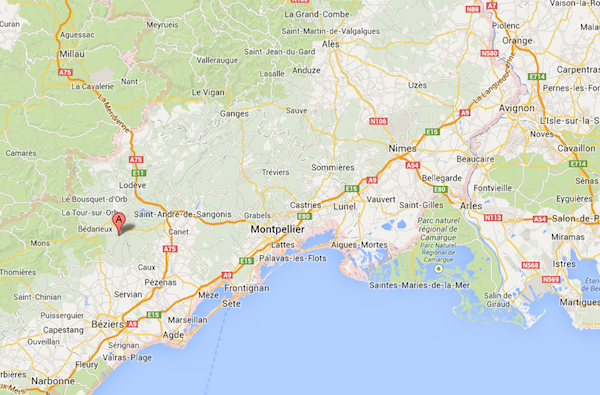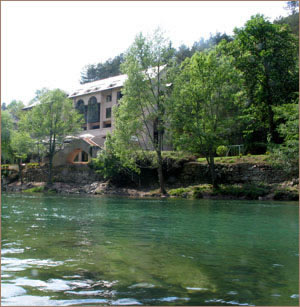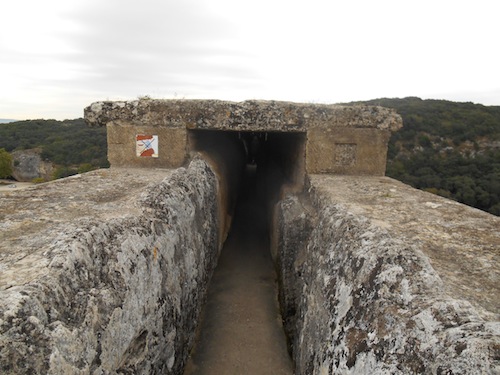France is twice the size of Britain and has a population of just over 62m – a few thousand more than the UK – which is why there is so much more space to get away from the hustle and bustle of people, writes Avril O’Connor
The lack of crowds in France, even at major tourist attractions is always a source of great joy and amazement to me. Take the Longuedoc-Rouissillon region which is neighbour to the much flashier Côte de Azur.
The area is home to six Unesco world heritage sites including the Pont du Gard, Canal du Midi, the medieval city of Carcassone, the Saint-Jaque-de-Compostella pilgrimage routes, the Vauban fortresses of Mont Louis and Villefranche-de-Conflent, as well as the Causses and the Cévennes region. It also has ten “Grand Sites de France”, 13 villages with the prestigious title “Les plus beaux villages de France” and 11 Cathar castles.
More popularly known as the Languedoc, it includes the western Mediterranean coast of France, stretching from the Rhone valley in the east, to the Spanish border in the south west and eastwards towards the Alpes and Provence, and comprises five departments: four of which are Mediterranean coastal departments: the Gard , the Hérault, the Aude and the Eastern Pyrenees or Pyrénées orientales.

The Languedoc Roussillon region – from the department of Lozère in the north, the Pyrennees in the west towards Provence and the coast which embraces Montpellier and the Carmague
The fifth upland department of Lozère, forms the southern bastion of the Massif Central and this is where we start our journey. This is the most sparsely-populated department – also known as the Haute Languedoc, it is part of the Parc National de Cévennes – an area of unique limestone geology with high plateaux known as ‘causses” and deep river gorges.
Contrasting with the deep green ravines, the causses seem an endless expanse of grey, rocky semi-desert. The dry ground formed of limestone rock soaks up rainwater like a sponge, yet beneath this arid surface is a hive of aquatic activity. Here you can find some of the world’s largest caves (more about these later.)
The plateaux, some 1000m/3 280ft above sea level, have dry scorching summers and long cold winters, with deep snows and violent sweeping gales. The grazing of sheep and other animals in summer has also contributed to the bare landscape.

An inquisitive local!
It is an area of outstanding natural beauty, rich in wildlife and with little traffic on the narrow local roads, most of which are flat and perfect for cycling.

Donkeys – friendly locals of the causses
Amid the clumps of white rocks, growing wild there is holm-oak, broom and aromatic wild thyme and rosemary, alongside the cultivated olive trees, mulberry bushes and vines.
Autumn and spring are perfect times to enjoy the scenery since it is still warm and sunny but temperatures are comfortable.
Cirque de Navacelles

Cirque de Navacelles viewed from the Belvedere de la Baume Auriol
An ecological and geological marvel, the Cirque de Navacelles, in the Causses/Cevennes, is considered one of the most spectacular landscapes in France. It is a 300m canyon which looks as if it has been made by a giant meteor but has been hollowed from the limestone by the River Vis, at the heart of which lies the old Navacelles village.
The best view is at the Belvédère de la Baume Auriol where visitors get a breathtaking panorama. There is also a tourist shop showcasing local food and wine including the cheeses of Roquefort and Pélardon and the wines of the Terrasses du Larzac and the Coteaux du Languedoc.
Land of the Vulture
An armchair “twitcher’ by way of BBC Countryfile I was fascinated by a conservation project which has brought back vultures to the region. And I discovered that far from being a nuisance – they are in fact nature’s cleaners. They do not kill but only eat dead animals and they literally have their own pecking order.
Three species of vulture are now thriving in the region, after being reintroduced through this project which also encourages tourists by way of the Maison de Vultures, in the Gorges de la Jont, near the village of Meyrueis.
All species of vulture had been extinct in the area since the 1940s – either shot, poisoned or starved out of existence. The birds are now protected and local farmers have a government dispensation to leave the carcasses of animals, in specially designated carrion areas, for the vultures to feed.

The centre, is co-owned by two local men, Gilles Vengely and Constant Bangnolini (pictured below) who are also the guides for visitors. The pair express their passion for the birds by sharing many local anecdotes including how vultures turned up at the funeral of a farmer who used to feed them – to pay their respects of course!

Co-owners Gilles Vengely and Constant Bagnolini
The museum is crammed with information and exhibits on vultures and their way of life. The observation terrace is discreetly built into the mountainside and there are binoculars (made by Swarovski I note) to watch the vultures in their natural habitat. Even so its difficult to spot them because their colouring means they blend into the rocks.
A must-do part of the experience is sitting down to a video which has captured live images of the vultures from the 3 separate cameras which are permanently pointed at the nests.

The vulture observation deck
This landscape is the ideal habitat for vultures. The updraughts created when the sun heats the cliff faces allows them to take flight on the thermals – they can glide for hours looking for prey. Their nests are on inaccessible rocky outcrops which can be identified by the white markings from their droppings.

The nearby slopes are covered with forests of Scots Pine and Oak
The conservation project has successfully introduced three types of raptors – the Griffin Vulture, which eats the soft flesh; the Black Vulture, with a wingspan of three metres and one of the largest, that eats the muscle and harder tissue and the Egyptian Vulture that consumes bones. During our visit we see only the Griffin vulture as the others migrate to warmer climes for winter.

Griffin Vultures

The skull of a wild boar lies by the roadside – we wonder where the rest of the animal went – maybe vultures?
Four star luxury in the Gorges du Tarn
The Grand Hotel de la Muse et du Rozier is situated at the heart of Gorges du Tarn with spectacular views.

Le Grand Hôtel de la Muse et du Rozier nestles in a beautiful river valley

Le Grand Hôtel de la Muse et due Rozier has a heated outdoor pool and a terrace overlooking the river

Le Grand Hôtel de la Muse et du Rozier – street view
This boutique hotel is run by Jean-Phillipe and Sandrine Boneville who set about renovating it after buying it in 2004. It’s classy and stylish, without being intimidating. A place to get-away from it all and relax. There is a whole host of activities to particpate in nearby, including walking and fishing. And expect five star food (and cocktails) as Jean-Phillipe was once deputy manager of a glitzy hotel on the Caribbean island of St Barts.
The Aven Armand Caves, Haures-la-Parade
Imagine a cave that is so large that even the Catherdral of Notre Dame would be dwarfed inside. This is the cave of Aven Armand. It’s mesmerising and fascinating – a forest of of more than 400 stalagmites, one of which is the highest in the world. And its easy to get to – there is a funicular rail car takes you down to 60 metres underground in less than 2 minutes.

Set against dramatic lighting (which is regularly dimmed to counter plant growth) this must be the most spectacular cave I have ever seen. There are more than 400 stalagmites that rise up, and one at 30 metres holds the world record.
Concerts are regularly held there because of the excellent acoustics and even car launches.
Pont du Gard

This aqueduct is truly an amazing site. The highest ever built by the Romans 2,000 years ago, to bring water to the inhabitants of Nîmes. It took a mere five years to build and demonstrates the incredible scientific knowledge of the engineers of the time. The aqueduct consists of 3 bridges of 6, 11 and 35 arches which were built on top of each other. It transported water from the River Eure and was fed along a canal using the natural downhill gradient to enable the water to flow towards Nîmes.

The water channel above was regularly cleaned to remove mineral deposits from the walls
Incredibly the bridge was once used by motor cars but is now protected by law – you can walk across it and also, with a guide, walk along the aqueduct channel (pictured above)
Today, the area is a World Heritage site with a museum, parking and cafe and the excellent Les Terraces restaurant, where you have view the pont with a glass of rose.

A 21st century marvel – the Millau Bridge designed by Norman Forster built between 2001-4 stands at a height of 270 metres
Aigues-Morts and bulls
In 1240, Louis IX decided to build a city close to his kingdom in order to have a direct access to the Mediterranean Sea. Aigues-Mortes, whichmeans dead water in the old Occitane language of the region – in an area of marshes, sand and water in the Petit Camargue. Seven centuries later, the fortification still dominates the Camargue as one of the most well preserved medieval French buildings.
« Le taureau de Camargue »
In Aigues-Mortes, as well as in other cities of Camargue, bulls are at the centre of economy, traditions and local culture; it involves a dedication to the worship of the bulls. During the local festival in October, the “abrivado“and “bandido” (bulls running through the streets with the gardians) cross the city from the North to the South and back again.
The bull games also offer an interesting show taking place in a unique arena made of wooden seating which local people bring along to view the spectacular.

The Rhone Canal flows into the sea at Aiges-Morts

The ramparts surround the town of Aiges-Morts
Don’t miss….
Lodève and the textile industry
Lodève is one of the larger rural cities in the region and was governed by bishops in the 18th and 19th centuries. It had the monopoly for the manufacture of cloth used for the uniforms of the Royal Infantry and it still retains many mansions and buildings from its rich past Visit the city and the cathedral with a guide. The carpet business is still thriving and we are told that the Élysée Palace recently refurbished with.
Meyrueis
Although only a small town, Meyrueis is pleasant to explore and in a picturesque location surrounded by steep wooded slopes.
The centre of the town is dominated by several small rivers, being at the confluence of the Jonte, Béthuzon and Brèze rivers, and it is these rivers and the numerous small bridges that make it so unique.
On a rocky outcrop on the hill high above the clocktower you can also see a small chapel, the Chapelle Notre-Dame du Rocher, built in the late 19th century on the site where a medieval castle stood from the 10th century until the 17th century. In the old town you can also see several impressive houses that date from the 16th to the 18th centuries.
The principal attraction of Meyrueis is undoubtedly its pleasant holiday atmosphere – there are very few towns in this region and here you can find numerous restaurants along the riverside, making Meyrueis an ideal place to find yourself at lunchtime when you are exploring the gorges and caves of the Tarn, Lozere and Aveyron.
Ferme Caussenard d’Autrefois
Go off the beaten track to find this privately-owned farm museum.
In this farm there are many architectural features such as arches and limestone slate roofs. Time has stood still for a century … From the stable to the sheep’s pen, from the kitchen to the “souilhardo”, from the rooms in the attic to the barn of baked bread … discover the daily life of the peasants of the Causse Mejean who lived and worked here until the 1950s, the old furniture, linens, dishes, tools and farm machinery, old photos, the film “Lou Mèjio”, a miniature village and some farm animals… relive a life which is so near and yet so far.
Telephone: + 33 (0)4 66 45 65 25 Fax: + 33 (0)4 66 45 65 25 Email: ferme-caussenarde@wanadoo.fr ferme.caussenarde.free.fr
St Gilles
Right opposite the tourist office at 1 Place Frederic Mistral is the entrance to the old medieval settlement and the 12th Century abbey which lies along the pilgrimage route to St Jacques de Compostela. The abbey is classified as World Heritage by UNESCO for its facade and is in itself a masterpiece of Roman art.

Wine & food
With 30 appellations and over 60 vins de pays including reds, whites, rosés, sparkling, still and naturally fortified wines, Languedoc-Roussillon wines are as diverse as the region.
Sud de France Languedoc-Roussillon destinations also offer a multitude of specialties including Cassoulet from Castelnaudary, anchovies from Collioure, oysters from Leucate, Gruissan and Bouzigues, brandade from Nimes, “le pélardon”, sweet onions from the Cévennes, rousquilles cookies from Vallespir, apricots from Roussillon, le Bleu des Causses, rice and salt from the Camargue, and Catalan and Lozérienne charcuterie, among countless other products.
Fact Box
Cirque de Navacelles
www.cirquenavacelles.com
About the Cirque de Navacelles
La Maison des Vautours
Vergely Gilles
48150 Le Truel – MEYRUEIS
T: 05.65.62.69.69 – Mobile: 06.32.02.82.92 – F: 05.65.62.69.67
www.vautours-lozere.com
E:
Aven Armand Grotto
48150 Hures-La Parade
T: 04 66 45 61 31
www.aven-armand.com E: contact@aven-armand.com
T: +33 (0)4 66 45 61 31 Address: Hures la Parade 48150 Hures-la-Parade
Site du Ponte du Gard
T: 04 66 37 51 10 F: 04 66 37 51 58
www.pontdugard.fr
Open all year round from 9am
Hotels
L’Hotel de la Paix
11 Boulevard Montalangue 34700 Lodève Tel + 33 (0)4 67 44 07 46
Hotel Restaurant de la Paix
Grand Hôtel del Muse et Du Rozier 4* in Aveyron
Les Gorges du Tarn
Mostuejouls 12720 Peyreleau
Aveyron
T: 33(0) 5 65 62 60 01 F: 33 (0) 5 6 5 62 63 88
www.hotel-delamuse.fr E: info@hotel-delamuse.fr
Hotel Family – Meyrueis
In this 3 star hotel with 48 bedrooms in the heart of the mountains, you will discover the calm of the exceptional surrounding environment. The terraces, gardens, swimming pools and the family spa allow you to enjoy good weather all year round. 4 Quai de la Barrière
48150 Meyrueis Tel : +33 (0)4 66 45 60 02
E: hotel.family@wanadoo.fr www.hotel-restaurant-family.com
Mas des Sables – Aigues-Mortes
Route de Nîmes 30220 Aigues-Mortes Tel : +33 (0)4 66 53 79 73
Webistte: Mas de Sables
Restaurants
Pont du Gard
Les Terrasses Pont du Gard
Built at the foot of the Pont du Gard in 1865, this former inn, situated on the Gardon’s right bank, is a modern-day jewel of this historic site. It enjoys an unbeatable view of one the Roman empire’s most beautiful monuments, providing
+33 (0)4 66 37 51 10.
Aigues-Morts
Restaurant Dit Vin
6 Rue du 4 Septembre 30220 Aigues-Mortes Tel: +33 (0)4 66 53 52 76
www.restoleditvin.com/
Useful websites
www.destinationsuddefrance.com
Hérault tourism development agency
Lozère Departmental Tourism Committee
St Gilles Tourist Office
and theAigues-Mortes tourist office www.ot-aiguesmortes.fr























